Guide to college entrance exams: SAT vs ACT, Choosing between the SAT and ACT is a major decision for college-bound students. Both exams play a crucial role in admissions, scholarships, and academic placement, but they differ in structure, content, and timing. Understanding these differences can help you play to your strengths and improve your chances of success. Whether you’re aiming for a top-tier university or just want to maximize your score, this guide breaks down everything you need to know about the SAT and ACT, so you can make the right choice and prepare with confidence.
Why College Entrance Exams Matter
Picture this: you’re a high school student juggling academics, extracurriculars, maybe a part-time job, and now you’re staring down the SAT or ACT. These exams have long been a rite of passage for college-bound students, holding the power to influence where you might land for your next academic chapter. But why do these tests matter so much?
College entrance exams are designed to provide a standardized measure of a student’s readiness for college-level work. They help admissions officers compare students from different high schools, states, or even countries. GPA can vary widely depending on the rigor of your school, but a standardized test score provides a common metric.
Colleges often use these scores not only for admission decisions but also for awarding scholarships, placement into honors programs, or determining course levels in subjects like math and English. Even in the age of test-optional policies, a strong SAT or ACT score can tip the scales in your favor, especially if your GPA isn’t stellar or if you’re applying to highly competitive programs.
Moreover, preparing for these exams fosters academic skills beyond the classroom. Think time management, critical thinking, and focused study habits—all of which are essential for success in college and beyond. Whether we love them or hate them, college entrance exams still carry weight and influence.
So if you’re serious about college, ignoring the SAT or ACT isn’t an option. Instead, it’s about understanding them, mastering them, and using them to showcase your potential. Let’s dive deeper and unpack what these tests are all about.
The SAT and ACT
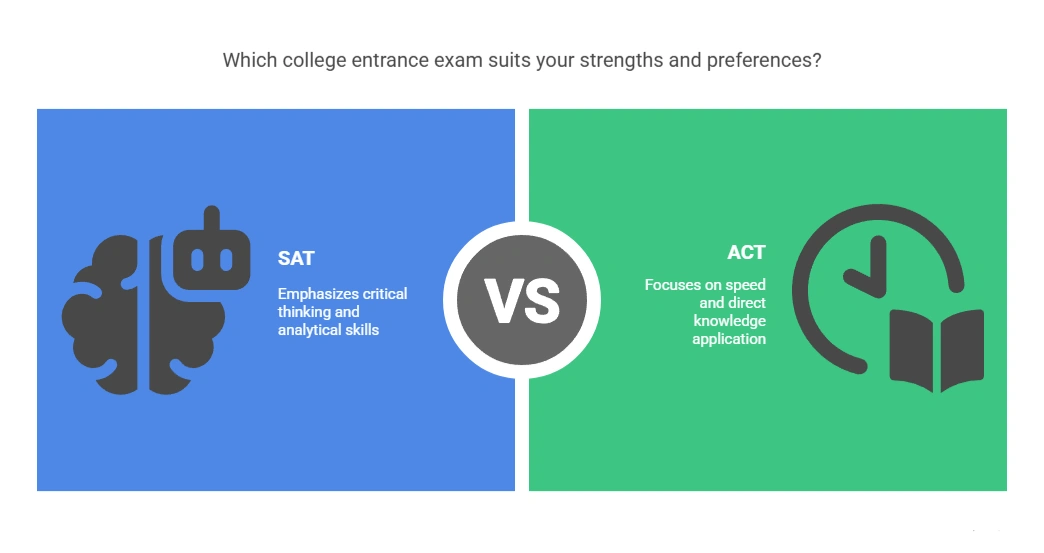
What is the SAT?
The SAT, short for Scholastic Assessment Test, is administered by the College Board. It’s designed to assess a student’s readiness for college and is accepted by almost all colleges and universities in the U.S. The SAT’s knowledge is in three main areas: Reading, Writing, Language, and Math. As of its latest version, it no longer includes an optional essay section (it was discontinued in 2021).
The SAT is known for its evidence-based reading and slightly trickier math problems that require more critical thinking than calculation. It’s scored on a scale of 400 to 1600, combining Math (200–800) and Evidence-Based Reading and Writing (200–800).
This test is typically seen as a bit more analytical. If you’re someone who excels in logic, puzzles, and understanding context clues, you might find the SAT a better fit.
Another thing to keep in mind: the SAT has been evolving. Recent changes include digital formats and adaptive testing, depending on the location and year of administration. These updates are making it more streamlined and tech-friendly for today’s test-takers.
What is the ACT?
On the flip side, the ACT—short for American College Testing—is administered by ACT, Inc. This exam is equally accepted by U.S. colleges and emphasizes a broader range of subjects. It includes four mandatory sections: English, Math, Reading, and Science, plus an optional Writing (Essay) section.
Yes, you read that right—the ACT includes a Science section, which sets it apart from the SAT. However, it’s more about scientific reasoning than actual science content, so you don’t need to memorize biology facts or chemical formulas.
The ACT is scored on a scale from 1 to 36, with each of the four main sections receiving its score, and the average of those becomes your composite score. The optional essay is scored separately.
The ACT is known for its fast pace. If you’re someone who reads quickly, works well under pressure, and prefers direct questions, the ACT could be your match. It’s also very straightforward in wording, which some students prefer over the SAT’s nuanced approach.
Brief History of Both Exams
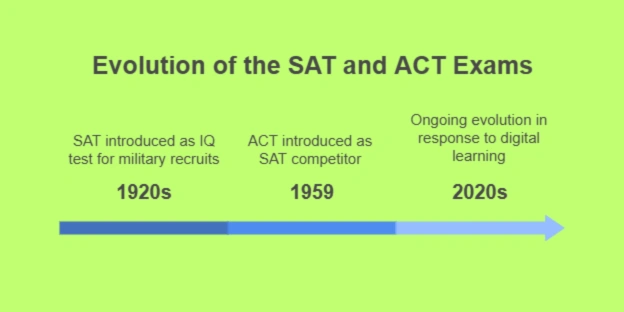
The SAT has been around since the 1920s, originally designed as an IQ test for military recruits before evolving into a college admissions tool. Over time, it has shifted from a vocabulary-heavy format to a more evidence-based assessment. Each revision has aimed to make it more relevant to high school curricula and college expectations.
The ACT, introduced in 1959, was created as a competitor to the SAT. From its inception, it was designed to test what students learn in school rather than their innate intelligence. As a result, it often aligns more closely with high school coursework.
Over the decades, both tests have undergone multiple transformations, especially in response to criticism about bias, accessibility, and fairness. With the rise of the test-optional movement and digital learning environments, these exams continue to evolve, but they remain significant tools in the college admissions toolkit.
Section Breakdown of the SAT
The SAT is divided into two main sections:
1. Evidence-Based Reading and Writing (EBRW)
- Reading: You’ll face five passages with 52 multiple-choice questions. Topics include U.S. and world literature, history/social studies, and science.
- Writing and Language: This portion has 44 questions based on four passages. Your job? Spot grammatical errors, improve sentence structure, and fine-tune clarity.
2. Math
- Split into two subsections: one that allows calculator use and one that doesn’t.
- 58 questions in total, covering algebra, problem-solving, data analysis, and advanced math (think functions and trigonometry).
Total Testing Time: 3 hours
Score Range: 400–1600
What makes the SAT unique is its emphasis on vocabulary in context and evidence-based reading. You’re often asked to support your answers with textual evidence, which requires close reading and comprehension.
Section Breakdown of the ACT
The ACT includes:
- English – 75 questions in 45 minutes. Focuses on grammar, sentence structure, and rhetorical skills.
- Math – 60 questions in 60 minutes. Includes algebra, geometry, and some trigonometry. Calculator allowed throughout.
- Reading – 40 questions in 35 minutes. Similar to SAT reading, but quicker and more straightforward.
- Science – 40 questions in 35 minutes. Based on interpreting graphs, hypotheses, and scientific information.
- Optional Essay – One prompt in 40 minutes, analyzing perspectives on a given issue.
> Total Testing Time (without essay): 2 hours 55 minutes
> Score Range: 1–36 per section, averaged for a composite score
ACT’s hallmark is its speed. Each section is tightly timed, testing your ability to read quickly and make fast decisions. It rewards precision under pressure.
Time Limits and Pacing Differences
Let’s break down one of the biggest challenges: timing.
| Section | SAT Time | ACT Time |
| Reading | 65 min | 35 min |
| Writing/English | 35 min | 45 min |
| Math | 80 min | 60 min |
| Science | N/A | 35 min |
| Essay (optional) | N/A | 40 min |
The ACT requires rapid thinking and time management. It’s almost like a sprint, while the SAT is more of a thoughtful jog. If you struggle with pacing, this could be a deciding factor.
Scoring Systems and What They Mean

SAT Scoring Explained
SAT scores range from 400 to 1600, combining:
- Math (200–800)
- Evidence-Based Reading and Writing (200–800)
There’s no penalty for wrong answers, so it’s in your best interest to attempt every question. The SAT also provides subscores for categories like Command of Evidence, Words in Context, and Problem Solving.
Percentile rankings tell you how you performed compared to other test-takers. For example, a 1300 might place you in the 88th percentile, meaning you scored better than 88% of testers.
Some colleges also “superscore,” which means they consider your highest section scores across multiple test dates.
ACT Scoring Explained
The ACT scores each of its four main sections from 1 to 36, then averages them for a composite score.
So if you scored:
- English: 30
- Math: 28
- Reading: 32
- Science: 29
Your composite score would be (30 + 28 + 32 + 29) ÷ 4 = 29.75 → rounded to 30.
The optional Writing section is scored separately from 2 to 12 and doesn’t affect your composite.
Just like with the SAT, many schools also accept ACT superscores, taking your best scores from multiple sittings to calculate a new composite.
Percentiles and Superscoring
Both tests use percentiles to show how you rank nationally, which can help you understand competitiveness. For example:
- SAT: A score of 1400 = ~94th percentile
- ACT: A score of 32 = ~97th percentile
Superscoring is a major advantage. If you excelled in Reading on one test date and Math on another, some colleges will combine your highest section scores. Not all schools do this, so check each college’s policy.
Subject Emphasis and Skills Tested
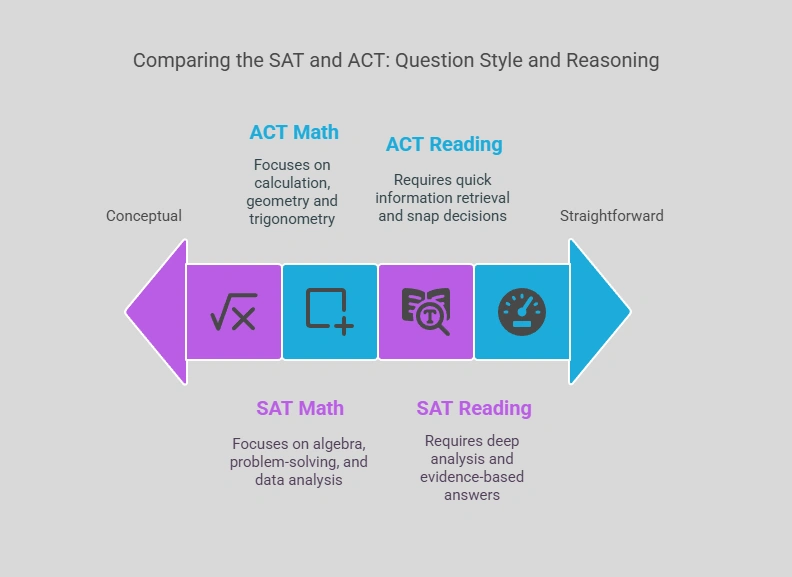
Math Focus: SAT vs ACT
Math can be a make-or-break section for many students, and both the SAT and ACT approach it differently. Understanding these differences can help you play to your strengths.
SAT Math Overview:
The SAT’s math section is more conceptual and focuses heavily on:
- Algebra and linear equations
- Problem-solving and data analysis
- Advanced math (functions, polynomials)
- Geometry (minor emphasis)
One big twist? A portion of the SAT Math section doesn’t allow calculator use. This section aims to test your fluency and number sense under pressure. You’ll need to be comfortable doing calculations by hand and managing your time efficiently.
Another key feature of SAT Math is the presence of grid-in questions. These require you to come up with your answers, rather than picking from multiple choice, which means guessing won’t work here.
ACT Math Overview:
The ACT’s math section is more straightforward and calculation-based. It covers:
- Algebra
- Geometry
- Trigonometry (more heavily than the SAT)
- Elementary statistics
You can use a calculator for the entire ACT Math section, which helps if you’re not confident with mental math. The ACT tends to cover a broader range of topics, though its questions are typically more direct.
Key Takeaway:
- Choose the SAT if you’re stronger in algebra and analytical reasoning.
- Pick the ACT if you’re better at applying formulas quickly and enjoy geometry or trigonometry.
Both exams reward practice, but the style of questions differs significantly. Think of SAT Math as a puzzle you need to solve and ACT Math as a race you need to complete efficiently.
English and Reading: Which Exam is More Challenging?
The English and Reading sections on both exams aim to test your grasp of grammar, comprehension, and language skills, but they approach these areas in very distinct ways.
SAT Reading & Writing:
- Reading passages often come from literature, historical documents, social sciences, and natural sciences.
- Questions are evidence-based, asking you to identify where in the passage you found your answer.
- Vocabulary in context plays a big role.
- Writing and Language tests grammar and sentence structure with 4 short passages.
ACT English & Reading:
- English section is grammar-heavy, with 75 questions in 45 minutes.
- Reading involves 4 long passages with 10 questions each.
- Questions are direct and focus on retrieving information quickly.
- Reading passages might be easier to understand, but you’ll need to move quickly due to tighter time constraints.
The Verdict:
- If you’re a fast reader and can make snap decisions, the ACT might suit you better.
- If you prefer diving deep and analyzing text with more time, the SAT could be your best bet.
Grammar and Style:
Both exams cover standard grammar rules, punctuation, and rhetorical skills. But the ACT English section is generally longer and faster-paced.
So, which is harder? That depends. The ACT is faster but simpler. The SAT is slower but more analytical. Try sample tests of both to see which feels more natural to you.
Science Section: Unique to ACT
This is where the ACT takes a unique turn. The SAT doesn’t have a dedicated science section, while the ACT includes a 35-minute science portion that can be a curveball if you’re not prepared.
What’s in the ACT Science Section?
- 40 questions based on 6–7 scientific passages.
- Topics include biology, chemistry, physics, and Earth/space science.
- You won’t need deep scientific knowledge—just the ability to interpret data, graphs, and experiments.
You might see:
- Research summaries describing lab experiments
- Data representation with charts or graphs
- Conflicting viewpoints on scientific theories
Skills Tested:
- Data analysis
- Critical thinking
- Evaluating hypotheses
- Drawing conclusions
Why It’s Not as Scary as It Sounds:
Despite the name, the ACT science section is more about scientific reasoning than memorizing facts. If you’re good at reading graphs and making logical inferences, you’ll thrive here.
No Science on the SAT?
While the SAT doesn’t have a separate science section, it does include science-based passages in its reading and writing portions, testing similar skills indirectly.
Pro Tip: If you’re considering a STEM major, doing well on the ACT science section can give your application a boost, even if the school doesn’t require it.
Preparation Strategies
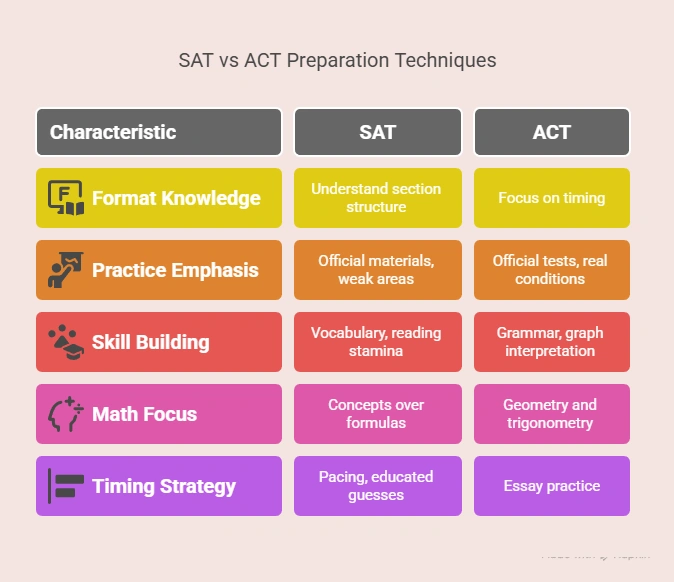
SAT Prep Techniques
Let’s face it—preparing for the SAT isn’t just about doing practice tests. It’s about building a game plan.
1. Know the Format:
- Start by understanding each section’s structure and types of questions. This prevents surprises on test day and helps you allocate your study time effectively.
2. Practice, Practice, Practice:
- Take full-length, timed practice tests.
- Use official SAT practice materials (like those from the College Board and Khan Academy).
- Focus on weak areas: If your Math scores are dragging, drill down on problem-solving and algebra.
3. Build Vocabulary and Reading Stamina:
- Read nonfiction: science articles, historical documents, and editorials.
- Learn new words in context rather than rote memorization.
- Annotate passages to improve retention.
4. Math Drill:
- Practice without a calculator.
- Understand concepts rather than just formulas.
- Review high school math topics thoroughly.
5. Timing Strategy:
- Learn to pace yourself: don’t get stuck on tough questions.
- Use elimination to make educated guesses.
Tools & Resources:
- College Board SAT prep
- Khan Academy (free, personalized)
- SAT prep books (Barron’s, Princeton Review)
- Apps like Magoosh or UWorld
Consistency is key. A solid 3-month study plan with daily practice can significantly raise your score.
ACT Prep Techniques
The ACT is a speed test, and your prep should reflect that. Here’s how to maximize your ACT prep.
1. Focus on Timing:
With tighter time limits, practice under real conditions. Use a stopwatch and simulate the full test.
2. Target Weak Sections:
If science or math is your Achilles’ heel, prioritize those early in your study schedule.
3. Master the Basics:
- Brush up on grammar rules for English.
- Review high school math thoroughly—especially geometry and trigonometry.
- Practice interpreting graphs and tables quickly for the science section.
4. Essay Practice:
If you’re opting in for the writing section, learn how to craft a solid argument in under 40 minutes. Practice with sample prompts and ask for feedback.
5. Use Official Practice Tests:
ACT, Inc. offers several free full-length tests online. These are your best bet for understanding real test questions.
Prep Resources:
- ACT Academy (free)
- Kaplan and Princeton Review ACT guides
- ACT Online Prep platform
- Magoosh ACT and PrepScholar
A solid ACT strategy involves more drills and quick decision-making than deep reading. Find your rhythm and stick to a study schedule of 1–2 hours daily.
Choosing the Right Exam for You
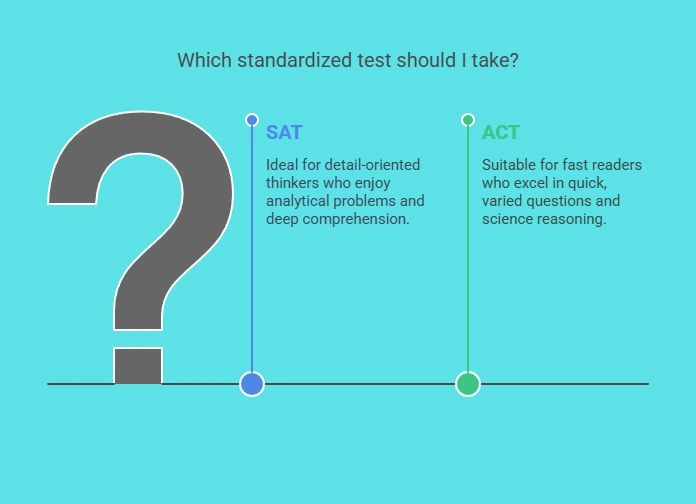
Learning Styles and Test-Taking Preferences
So, you’re stuck at the crossroads: SAT or ACT? The answer lies in your learning style and test-taking tendencies. The two exams are structured to test similar academic skills, but through very different lenses. Picking the right one can be a game-changer.
Are you a detail-oriented thinker who enjoys digging deep into problems?
If so, the SAT might be your match. It favors analytical minds, especially in reading comprehension and math reasoning. You’ll be rewarded for identifying patterns, providing textual evidence, and solving logic-based problems.
Do you prefer fast, straightforward questions with more variety in subjects?
Then lean toward the ACT. It’s perfect for students who are fast readers, good at memorizing and applying rules quickly, and confident across multiple disciplines, especially if you’re strong in science reasoning.
Here’s a quick rundown:
| Trait | Best Fit |
| Fast Reader, Quick Thinker | ACT |
| Strong in Algebra & Logic | SAT |
| Good with Charts & Graphs | ACT |
| Deep Comprehension Skills | SAT |
| Struggle with Time Pressure | SAT |
| Broad Subject Knowledge | ACT |
Take both a diagnostic SAT and ACT practice test. Your scores—and how you feel during each—can tell you a lot about which test suits you better.
Which Exam Do Colleges Prefer?
Here’s the good news: most colleges do not prefer one test over the other. Whether you submit SAT or ACT scores, colleges evaluate them equally in the admissions process.
That being said, here are some subtle realities to consider:
- Some schools in the Midwest and South lean slightly more ACT-heavy, historically due to regional testing norms.
- Elite schools like Ivy League colleges accept both tests and truly have no preference—what matters is how strong your score is relative to their applicant pool.
- Some scholarship programs or specific majors might request a certain test, especially if one includes more content aligned with your field (like ACT Science for STEM).
Don’t stress about preference. Focus on where you can score higher and show your strengths.
Regional and Institutional Trends
Although both exams are accepted nationwide, certain regions tend to favor one test over the other:
- ACT Strongholds: Midwest, South, and parts of the Rockies. Many public schools in these areas offer the ACT during the school day.
- SAT Territory: Northeast, California, and Washington State are more SAT-oriented, though ACT usage is growing.
At an institutional level, some colleges used to recommend one over the other, but this is increasingly rare in today’s test-optional landscape. Still, check with your target schools for any specific requirements or guidelines.
Some universities even partner with testing agencies to streamline admissions, so if your high school already integrates the ACT or SAT into the curriculum or state testing, that might nudge your decision.
When and How to Take the Exams
Registration and Costs
Registering for the SAT or ACT is straightforward, but don’t leave it until the last minute—test dates fill up fast, especially in popular months like October and December.
SAT Registration:
- Website: collegeboard.org
- Fee: Around $60 (waivers available for eligible students)
- You choose your testing center and preferred date
ACT Registration:
- Website: act.org
- Fee: Around $68 without writing, $93 with writing (waivers also available)
- Multiple test centers and dates are available throughout the year
Fee Waivers:
If you qualify for free or reduced lunch or other public aid programs, you may be eligible for up to two fee waivers per test. These also often cover college application fees.
Ideal Testing Timeline
Planning your testing schedule wisely can relieve tons of stress. Most students take the SAT or ACT for the first time in the spring of junior year and again in the fall of senior year.
Here’s a sample timeline:
- Freshman/Sophomore Year: Focus on core academic skills, take the PSAT (optional)
- Fall Junior Year: Take the PSAT/NMSQT (National Merit Scholarship qualifier)
- Spring Junior Year: Take your first SAT or ACT
- Summer: Prep intensively if needed
- Fall Senior Year: Retake for higher scores if necessary
- Winter: Send final scores to colleges
Early Decision or Early Action? Then you’ll want your final scores ready by October at the latest. Plan accordingly.
Retaking the SAT or ACT
Should you retake the exam? Absolutely—if you think you can improve. Most students increase their scores the second time around thanks to familiarity with the format and refined study strategies.
Benefits of Retaking:
- Higher scores
- Superscoring potential
- Improved scholarship eligibility
Limitations:
- Time and cost
- Diminishing returns after 2–3 retakes
- Can interfere with other senior year responsibilities
Both the College Board and ACT, Inc. let you choose which scores to send to colleges, so there’s no harm in retaking as long as you prepare well between attempts.
Test-Optional Movement and Its Impact
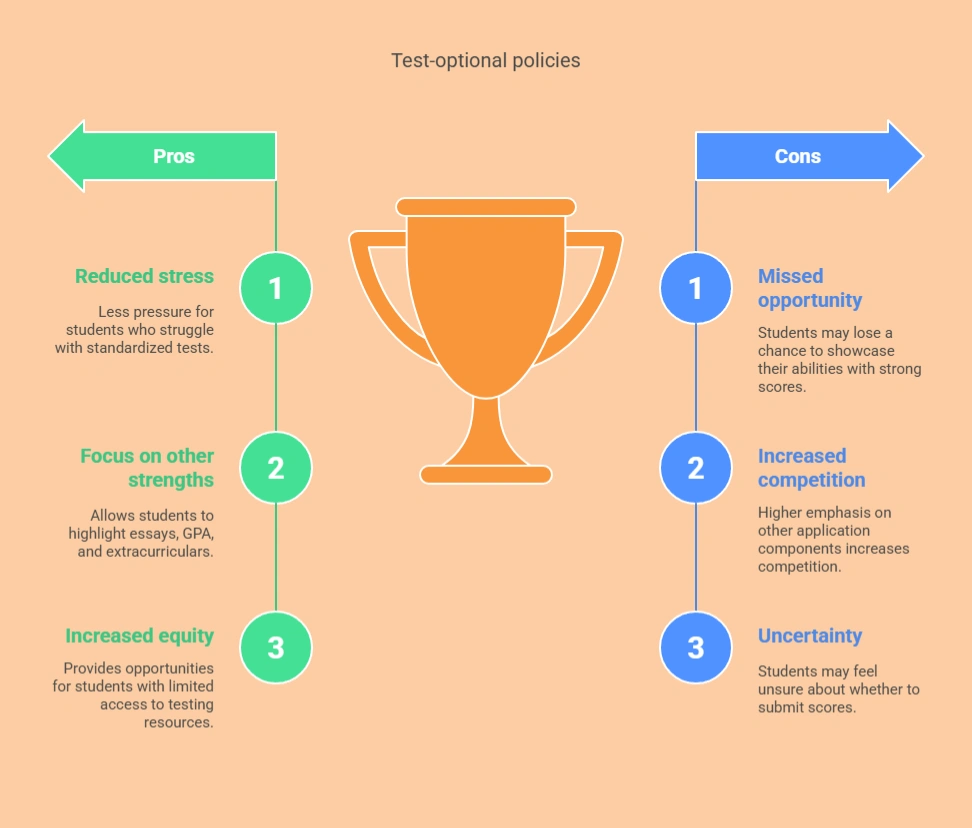
What Does Test-Optional Mean?
Over the past few years, a growing number of colleges have adopted test-optional or test-blind policies. But what’s the difference?
- Test-Optional: You can submit SAT or ACT scores if you want, but it’s not required.
- Test-Blind: Schools won’t consider test scores at all, even if you send them.
Test-optional policies gained popularity during the COVID-19 pandemic, when testing centers were closed. But many colleges have since extended or made these policies permanent.
What It Means for You:
- A strong score can still help you stand out, especially if your GPA is average.
- If you’re a poor test-taker, this offers relief, but your essays, GPA, and extracurriculars will carry more weight.
How to Navigate Admissions Without Scores
- If you decide to go test-optional, focus on building a stellar application through:
- Strong personal statement and supplemental essays
- Solid letters of recommendation
- Meaningful extracurricular activities and leadership
- A high GPA with rigorous coursework
Some schools offer portfolio-based reviews, especially for arts and creative programs. Others use interviews more heavily.
Bottom line: it’s still possible to shine without scores—but you’ll need to be intentional and strategic.
The Future of Standardized Testing
Standardized testing isn’t going away, but it’s certainly evolving. Here are some trends to watch:
- Digital SAT: Already rolling out in 2024–2025, it features a shorter, adaptive format.
- More Test-Optional Schools: Especially liberal arts colleges and some major public universities.
- Increased Equity Measures: Fee waivers, school-day testing, and prep resources are becoming more accessible.
Ultimately, students should see the SAT and ACT not as barriers, but as opportunities to showcase their readiness, on their terms.
Expert Opinions on SAT vs ACT
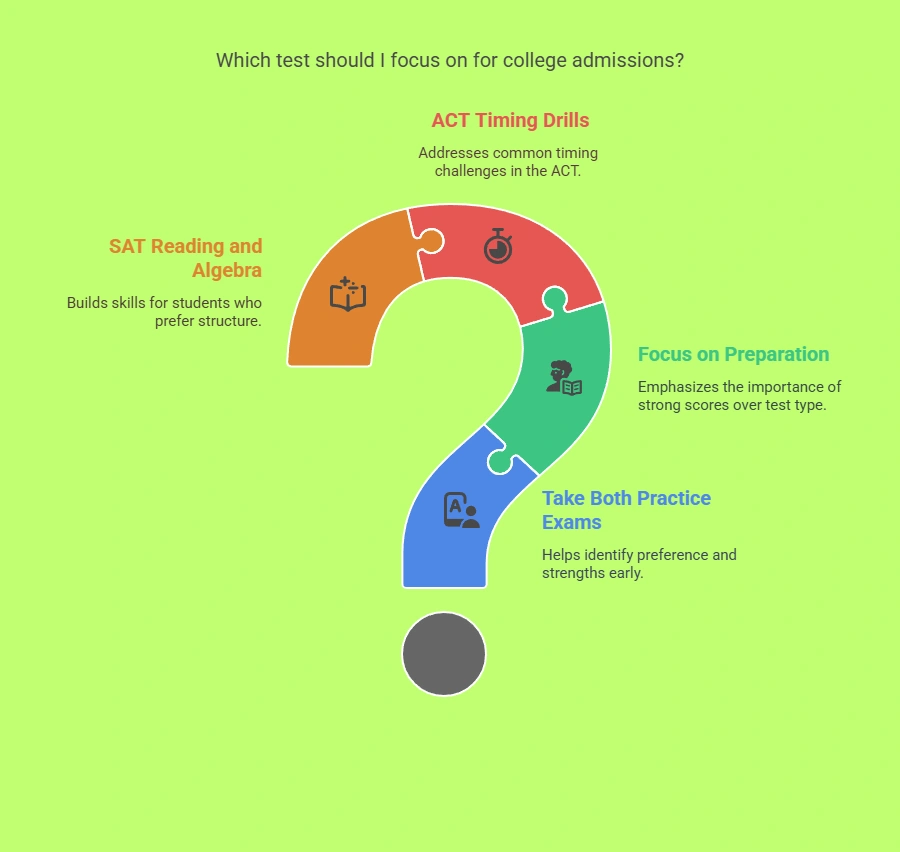
Advice from College Counselors
“Take both practice exams early—ideally, sophomore year. Most students quickly develop a preference. Once you find your stronger test, double down and prep hard for that one.”
— Rachel Thompson, College Advisor
“Don’t overthink it. What matters more than which test you choose is how well you prepare. Schools care more about strong scores and effort than the actual test type.”
— James Clark, High School Guidance Counselor
Insights from Test Prep Professionals
“Students often underestimate timing on the ACT. That’s where most people lose points. Our ACT prep focuses heavily on time drills.”
— Emily Zhao, ACT Tutor
“For the SAT, we work on building reading stamina and algebra fluency. It’s a great test for students who like structure and context clues.”
— Andre Martinez, SAT Instructor
Finally Making the Right Choice
Summing Up the Differences
Choosing between the SAT and ACT can feel like a massive decision, but once you strip it down, it’s really about understanding what each test asks, and how you respond under pressure.
| Feature | SAT | ACT |
| Total Time | 3 hours | 2 hours 55 minutes |
| Sections | Reading, Writing, Math | English, Math, Reading, Science, (Essay optional) |
| Scoring | 400–1600 | 1–36 |
| Science Section | No | Yes |
| Calculator Usage | Partial | Full Math Section |
| Pace | Slower | Faster |
Take diagnostic tests, analyze your strengths, and pick the one that sets you up for success.
Encouragement for Decision-Making
Remember this: you are more than your test scores. Whether you ace the SAT, crush the ACT, or go test-optional, your college journey will be shaped by who you are, not just how you bubble in answers.
Take ownership of your decision. Embrace your prep journey. And trust that, with the right tools and attitude, you’ve got what it takes to succeed.
Conclusion
Guide to college entrance exams: SAT vs ACT, The SAT and ACT are more than just standardized tests—they’re gateways to opportunities, confidence boosters, and sometimes, stepping stones to scholarships and honors programs. By understanding their structures, nuances, and what they test, you can choose the path that best suits your strengths.
Whether you opt for the analytical approach of the SAT or the fast-paced versatility of the ACT, preparation is your secret weapon. And if tests just aren’t your thing? The test-optional movement is proof that colleges care about the full picture.
FAQ
Can I take both the SAT and ACT?
Guide to college entrance exams: SAT vs ACT, Yes, and many students do! Taking both can help you see which test suits you better and where you score higher. Some colleges also superscore across multiple test attempts.
How many times can I retake these exams?
Guide to college entrance exams: SAT vs ACT, There’s no official limit. Most students take the SAT or ACT 2–3 times. However, too many retakes with minimal improvement can be a red flag for some admissions officers.
What if I have test anxiety?
Guide to college entrance exams: SAT vs ACT, Test anxiety is common. Try meditation, breathing techniques, or practice tests to reduce stress. Consider the test-optional route if your anxiety significantly affects your performance.
How long are SAT and ACT scores valid?
Guide to college entrance exams: SAT vs ACT, SAT and ACT scores are valid for five years, though some schools may prefer scores within the last two to three years for relevance.
Do all colleges accept both the SAT and the ACT?
Guide to college entrance exams: SAT vs ACT, Yes, almost all U.S. colleges accept either test. Always check with specific schools to confirm, especially if applying internationally.











